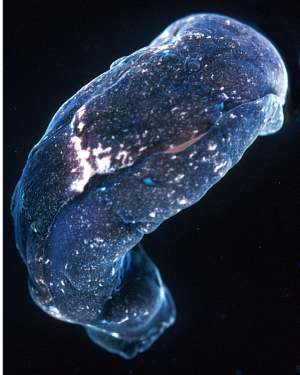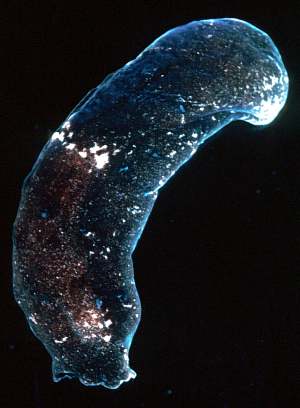
Melanochlamys queritor
(Burn, 1958)
Order: CEPHALASPIDEA
Superfamily: PHILINOIDEA
Family: Aglajidae
DISTRIBUTION
Temperate Australia [New South Wales to Western Australia]
PHOTO
Long Reef, Collaroy, Sydney, NSW, Australia. 21 September 1979. Photo: John Fields.
Melanochlamys queritor has the compact cylindrical shape, typical of the genus. The head shield has a short rounded posterior end only slighly overlapping the posterior shield. The parapodia are also relatively short lying tightly against the body and reaching just slightly onto the dorsal surface of the posterior shield. It ranges in color from almost black to almost white. The dark form is essentially black with patches of white speckling on either side of the head, along the posterior edge of the head shield, and near the posterior end of the posterior shield. There are also a variable number of small translucent clear specks scattered over the body, and a few larger bluish patches. Pale colour forms, which are essentially light brown or cream with darker spots, were previously considered a separate species, M. henri.
Like its New Zealand counterpart, Melanochlamys cylindrica, the dark colour form is often found in algal turf on rock platforms. Pale colour forms are usually found burrowing in soft sediments (Burn (1989). Burn reported (1958) that it feeds on algae, but later (1989) confirmed that it to feeds on polychaete worms.
References:
• Burn, R.F. (1958) A new species of opisthobranch from Victoria (Mollusca, Gastropoda). The Victorian Naturalist, 74: 115-117. [stated date 1957]
• Burn, R.F. (1989) Opisthobranchs (Subclass Opisthobranchia). [In] Marine Invertebrates of Southern Australia, Part 2. [Eds: Shepherd,S.A., Thomas, I.M.] Government Printer (South Australia), Adelaide, 725-788.
• Rudman, W.B. (1972) On Melanochlamys Cheeseman, 1881, a genus of the Aglajidae (Opisthobranchia: Gastropoda). Pacific Science, 26(1): 50-62, 8 figs.
• Rudman,W. B. (1972) Structure and functioning on the gut of the Bullomorpha (Opisthobranchia). Part 4. Aglajidae. Journal of Natural History, 6(5): 547-560, 8 figs.
• Rudman, W.B. (1974) A comparison of Chelidonura, Navanax and Aglaja with other genera of the Aglajidae (Opisthobranchia, Gastropoda). Zoological Journal of the Linnean Society, 54(3): 185-212.
Rudman, W.B., 2003 (May 11) Melanochlamys queritor (Burn, 1958). [In] Sea Slug Forum. Australian Museum, Sydney. Available from http://www.seaslugforum.net/find/melaquer
Related messages
Philine sp. from sthn Queensland
September 3, 2009
From: Gary Cobb
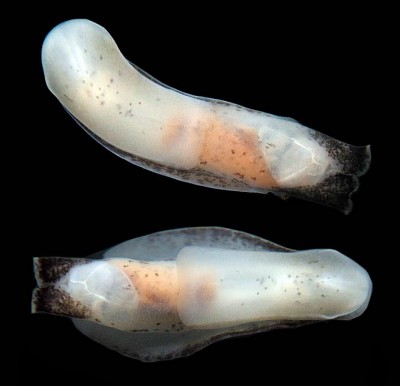
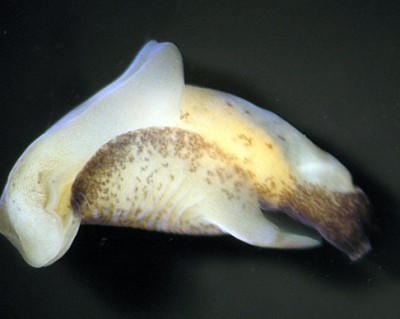
Concerning message #22053:
Hi Bill and everyone!
After a couple dives at Flinders Reef we came inside the Bay to have a spot of lunch. Me always trying to get as much as possible decided to have a sieving session just off the beach at Bulwer again. 3 sieves later we found Philine sp. which is different from anything we have seen.
Locality: Bulwer Beach, Moreton Island, 4 m, Queensland, Australia, Pacific Ocean, 01 August 2009, Subtidal. Length: 21 mm. Photographer: Gary Cobb.
Cheers
Gary
gary@nudibranch.com.au
Cobb, G.C., 2009 (Sep 3) Philine sp. from sthn Queensland. [Message in] Sea Slug Forum. Australian Museum, Sydney. Available from http://www.seaslugforum.net/find/22620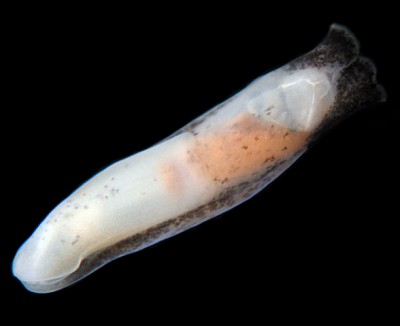
Dear Gary,
Thanks for another interesting find. Without having a look at its anatomy I can't be sure but my guess is that this is an aglajid rather than a philinid. There are some small species of Philine which have this elongate cylindrical shape but I would expect to see some sign of either calcareous or horny gizzard plates through the translucent body wall. I think I can see a sign of a bulbous buccal mass at the front of the body which would fit with a species of Melanochlamys. It reminds me a lot of the pale form of Melanochlamys queritor which is at present known from parts of New South Wales and Victoria.
I can see the fragile internal shell, at the posterior end of the body, as been cracked. Its shape also fits the photos I have on the Forum of the shell of M. queritor.
Best wishes,
Bill Rudman
Shell of Melanochlamys queritor
February 14, 2005
From: Bill Rudman
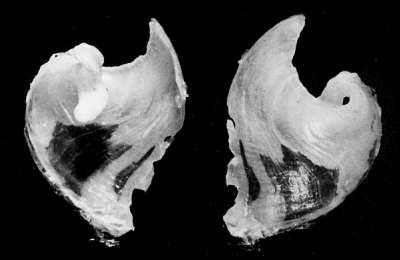
To accompany my recent posting of the shell of Melanochlamys lorrainae from New Zealand, here is a photo of the shell of the similarly coloured Melanochlamys queritor from south-eastern Australia. Although the photographed shell is partly decalcified after a long storage in alcohol, its shape is still clear, showing it to be quite similar to the shell of Melanochlamys cylindrica [see message #12805], with very reduced inner whorls, rather than the shell of M. lorrainae, with a quite large inner whorl.
Photo: Shell of M. queritor from animal collected at Port Lonsdale, Victoria, Australia, 22 November 1968 by R. Burn. Shell dimensions: 4.5 x 3 mm. Photo: G.W.Batt.
Bill Rudman
Rudman, W.B., 2005 (Feb 14) Shell of Melanochlamys queritor. [Message in] Sea Slug Forum. Australian Museum, Sydney. Available from http://www.seaslugforum.net/find/13137Melanochlamys queritor from eastern Australia
May 15, 2003
From: Bill Rudman
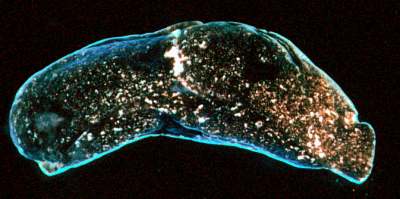
To continue building on the aglajids, here are some photos of another southeastern Australian species Melanochlamys queritor. I have not found it commonly in New South Wales. Both the animals illustrated here have been found in coralline turf on intertidal rock platforms, much like M. cylindrica in New Zealand.
Upper Photo: Port Stephens, NSW, Australia. May 1993. AM C173825. Photo: Bill Rudman
Lower Photos: Long Reef, Collaroy, Sydney, NSW. 20mm long alive. 21 September 1979. AM C117716. Photo: John Fields
Previously known from southern Australia, [Victoria to Hopetown, Western Australia], this is the first record from New South Wales.
Best wishes,
Bill Rudman

